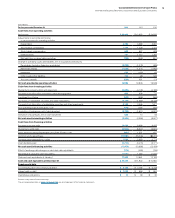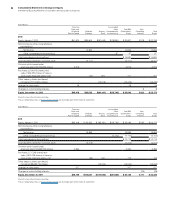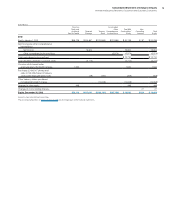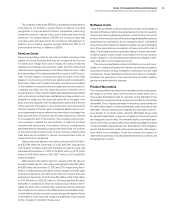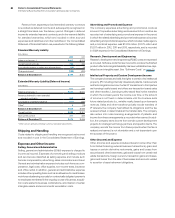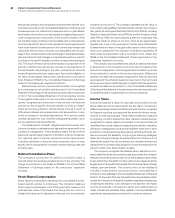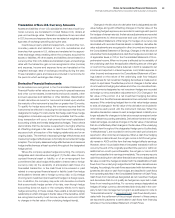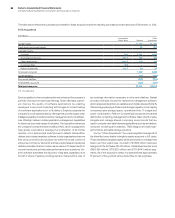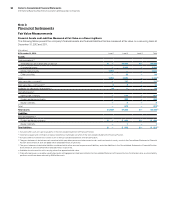IBM 2012 Annual Report Download - page 84
Download and view the complete annual report
Please find page 84 of the 2012 IBM annual report below. You can navigate through the pages in the report by either clicking on the pages listed below, or by using the keyword search tool below to find specific information within the annual report.
Notes to Consolidated Financial Statements
International Business Machines Corporation and Subsidiary Companies
83
Translation of Non-U.S. Currency Amounts
Assets and liabilities of non-U.S. subsidiaries that have a local func-
tional currency are translated to United States (U.S.) dollars at
year-end exchange rates. Translation adjustments are recorded
in OCI. Income and expense items are translated at weighted-aver-
age rates of exchange prevailing during the year.
Inventories, property, plant and equipment—net and other non-
monetary assets and liabilities of non-U.S. subsidiaries and
branches that operate in U.S. dollars are translated at the approxi-
mate exchange rates prevailing when the company acquired the
assets or liabilities. All other assets and liabilities denominated in a
currency other than U.S. dollars are translated at year-end exchange
rates with the transaction gain or loss recognized in other (income)
and expense. Income and expense items are translated at the
weighted-average rates of exchange prevailing during the year.
These translation gains and losses are included in net income for
the period in which exchange rates change.
Derivative Financial Instruments
All derivatives are recognized in the Consolidated Statement of
Financial Position at fair value and are reported in prepaid expenses
and other current assets, investments and sundry assets, other
accrued expenses and liabilities or other liabilities. Classification
of each derivative as current or noncurrent is based upon whether
the maturity of the instrument is less than or greater than 12 months.
To qualify for hedge accounting, the company requires that the
instruments be effective in reducing the risk exposure that they are
designated to hedge. For instruments that hedge cash flows, hedge
designation criteria also require that it be probable that the under-
lying transaction will occur. Instruments that meet established
accounting criteria are formally designated as hedges. These criteria
demonstrate that the derivative is expected to be highly effective
at offsetting changes in fair value or cash flows of the underlying
exposure both at inception of the hedging relationship and on an
ongoing basis. The method of assessing hedge effectiveness and
measuring hedge ineffectiveness is formally documented at hedge
inception. The company assesses hedge effectiveness and measures
hedge ineffectiveness at least quarterly throughout the designated
hedge period.
Where the company applies hedge accounting, the company
designates each derivative as a hedge of: (1) the fair value of a rec-
ognized financial asset or liability, or of an unrecognized firm
commitment (fair value hedge attributable to interest rate or foreign
currency risk); (2) the variability of anticipated cash flows of a
forecasted transaction, or the cash flows to be received or paid
related to a recognized financial asset or liability (cash flow hedge
attributable to interest rate or foreign currency risk); or (3) a hedge
of a long-term investment (net investment hedge) in a foreign opera-
tion. In addition, the company may enter into derivative contracts
that economically hedge certain of its risks, even though hedge
accounting does not apply or the company elects not to apply
hedge accounting. In these cases, there exists a natural hedging
relationship in which changes in the fair value of the derivative, which
are recognized currently in net income, act as an economic offset
to changes in the fair value of the underlying hedged item(s).
Changes in the fair value of a derivative that is designated as a fair
value hedge, along with offsetting changes in the fair value of the
underlying hedged exposure, are recorded in earnings each period.
For hedges of interest rate risk, the fair value adjustments are recorded
as adjustments to interest expense and cost of financing in the
Consolidated Statement of Earnings. For hedges of currency risk
associated with recorded financial assets or liabilities, derivative fair
value adjustments are recognized in other (income) and expense in
the Consolidated Statement of Earnings. Changes in the fair value of
a derivative that is designated as a cash flow hedge are recorded, net
of applicable taxes, in OCI, in the Consolidated Statement of Com-
prehensive Income. When net income is affected by the variability of
the underlying cash flow, the applicable offsetting amount of the gain
or loss from the derivative that is deferred in AOCI is released to net
income and reported in interest expense, cost, SG&A expense or
other (income) and expense in the Consolidated Statement of Earn-
ings based on the nature of the underlying cash flow hedged.
Effectiveness for net investment hedging derivatives is measured on
a spot-to-spot basis. The effective portion of changes in the fair value
of net investment hedging derivatives and other non-derivative finan-
cial instruments designated as net investment hedges are recorded
as foreign currency translation adjustments in OCI. Changes in the
fair value of the portion of a net investment hedging derivative
excluded from the effectiveness assessment are recorded in interest
expense. If the underlying hedged item in a fair value hedge ceases
to exist, all changes in the fair value of the derivative are included in
net income each period until the instrument matures. When the
derivative transaction ceases to exist, a hedged asset or liability is no
longer adjusted for changes in its fair value except as required under
other relevant accounting standards. Derivatives that are not desig-
nated as hedges, as well as changes in the fair value of derivatives
that do not effectively offset changes in the fair value of the underlying
hedged item throughout the designated hedge period (collectively,
“ineffectiveness”), are recorded in net income each period and are
reported in other (income) and expense. When a cash flow hedging
relationship is discontinued, the net gain or loss in AOCI must gener-
ally remain in AOCI until the item that was hedged affects earnings.
However, when it is probable that a forecasted transaction will not
occur by the end of the originally specified time period or within an
additional two-month period thereafter, the net gain or loss in AOCI
must be reclassified into earnings immediately. The company reports
cash flows arising from derivative financial instruments designated as
fair value or cash flow hedges consistent with the classification of cash
flows from the underlying hedged items that these derivatives are
hedging. Accordingly, the cash flows associated with derivatives des-
ignated as fair value or cash flow hedges are classified in cash flows
from operating activities in the Consolidated Statement of Cash Flows.
Cash flows from derivatives designated as net investment hedges
and derivatives that do not qualify as hedges are reported in cash
flows from investing activities. For currency swaps designated as
hedges of foreign currency denominated debt (included in the com-
pany’s debt risk management program as addressed in note D,
“Financial Instruments,” on pages 94 to 98), cash flows directly asso-
ciated with the settlement of the principal element of these swaps
are reported in payments to settle debt in cash flows from financing
activities in the Consolidated Statement of Cash Flows.


